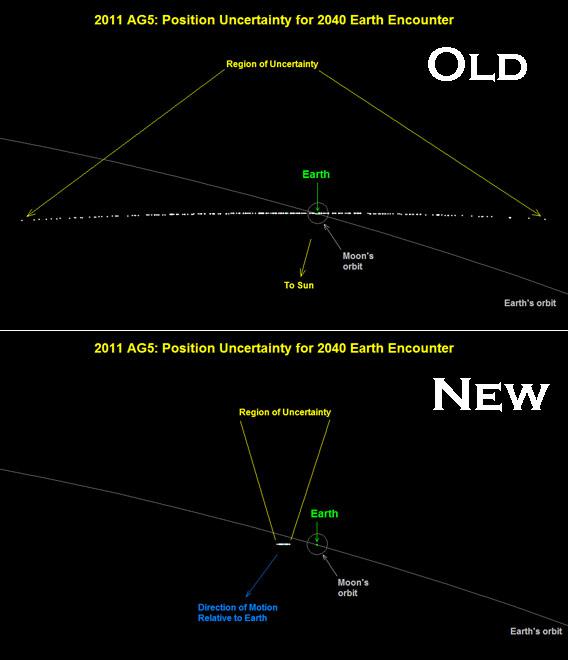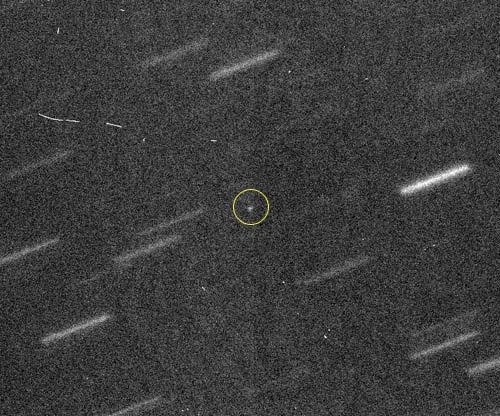Yay! Asteroid 2011 AG5 will not hit us in 2040! Up until now, I couldn’t say that with perfect certainty.
Here’s the scoop: Last year, a 140-meter rock was discovered on an orbit that takes it very near the Earth. Projecting the orbit forward in time showed that it had a small but non-zero chance of impacting the Earth in the year 2040. That would be bad: It would explode upon impact with a yield of more than 100 megatons, far larger than even the biggest nuclear weapon ever detonated on Earth. While that wouldn’t cause a worldwide extinction event—this is no dinosaur-killer—an explosion equal to blowing up 100 million tons of TNT is something to be avoided.
The odds of impact were only about 1 in 500, but that’s still too high to rest easy. The problem is that initially, the asteroid’s orbit was difficult to determine well enough to predict where it would be more than a few years in the future. The analogy I like is pretending you’re an outfielder in a baseball game, and as soon as the batter hits the ball, you have to close your eyes. How do you know where the ball will be when it comes down? If you can only get a second to look at it after it’s hit, you only have a vague idea where it will land. But the longer you can track it, the more accurately you can see where it’s headed. Track it long enough and you can catch it.
It’s the same with asteroids. Earlier in 2012 only a few observations of AG5 could be made before it got too close to the Sun to see. Those allowed the crude estimate of where it would be in 2040, and that big fuzzy volume of space included the Earth.

Image credit: NASA/JPL/Paul Chodas
However, new observations taken with the monster Gemini telescope in Hawaii allowed a far better orbit to be calculated. The path of the asteroid in 2040 was found, and now clearly does not include the Earth. It will be a clean miss, by about 900,000 kilometers (550,000 miles). This is more than twice the distance to the Moon, if that helps.
The diagram above shows this: The upper picture shows the uncertainty in the region of space the asteroid would pass in 2040, and Earth is in that region. The lower picture shows the new calculations, with the asteroid missing us entirely.
I reported on this asteroid back in March 2012. At the time, with the impact risk of 0.2 percent, some people were concerned about AG5. One of those was Apollo 9 astronaut Rusty Schweickart, who is now with the B612 Foundation, a group dedicated to understanding and preventing asteroid impacts. He urged NASA to work on a plan to do something about the asteroid, should further observations make the odds for an impact higher.
Part of the problem at the time was that the asteroid was too close to the Sun to observe, and while there was a short window to observe in October 2012, it wouldn’t be until September 2013 that AG5 would be clear enough from the Sun to easily observe it. Schweickart didn’t want to lose a whole year should the asteroid prove dangerous.
Eventually NASA did perform an initial investigation into this, but now, happily, it won’t be needed. The October window worked out, the orbit refined, and now we know it’ll miss.
But this exercise was hardly a waste of time. The lessons learned were important. There are more asteroids out there, and given enough time the odds climb to certainty that we will be hit if we do nothing. The good news is we are looking for them, and hopefully, should we find one with our name on it, we’ll have enough time to be able to do something about it.
As for what we can do, stay tuned. I’ll have more about that shortly.
Tip o’ the Whipple shield to AsteroidWatch on Twitter.
